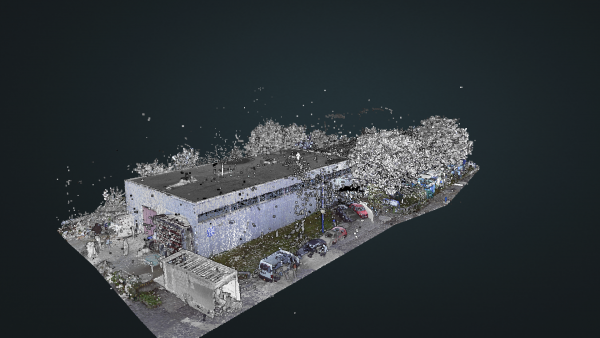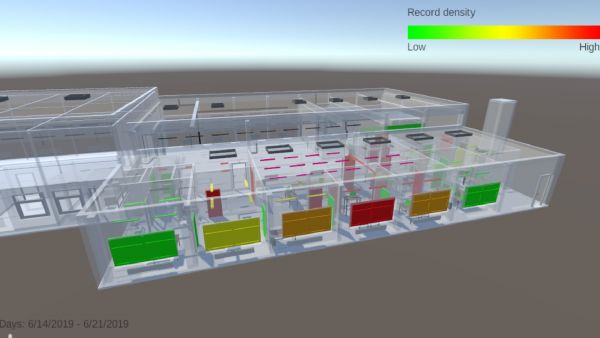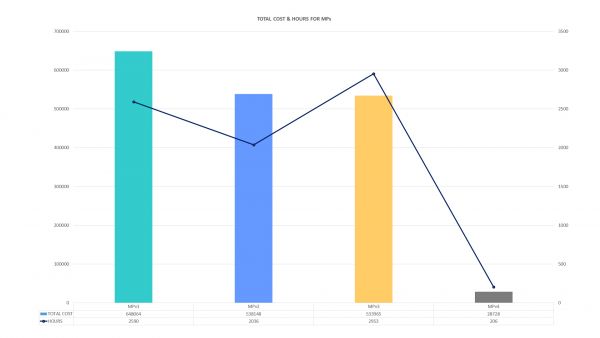SCI_BIM - Scanning and data capturing for Integrated Resources and Energy Assessment using Building Information Modelling
Short Description
Motivation and research question
Due to the rapidly increasing consumption of resources and land worldwide, as well as the growing generation of waste, the building stock plays a crucial role not only for the reduction of the energy consumption, but also as a future source of materials (urban mining). However, there is a lack of information on the detailed material composition of the building stock, which is the main obstacle for modelling and predicting its future use. Therefore, the main research question is whether the use of the digital technologies "Laser Scanning" and "Ground Penetrating Radar" (GPR) as well as a gamification concept, enable to develop and maintain a digital twin (BIM model) which serves as a basis for urban mining.
Initial situation/status quo
Building stocks and infrastructures are the largest material stock of industrial economies. The global material stock is about as large as reserves of primary resources in nature. It is of long-term importance to maintain or frequently recycle the urban material stock in order to minimize the use of primary resources and thus the dependency on imports – a strategy called "urban mining".
Simultaneously, buildings consume about 35% of energy worldwide and cause about 40% of global CO2 emissions [Abergel et al., 2017]. With a new construction rate of 3% [Euroconstruct, 2018], the existing building stock is crucial for minimising energy consumption.
Project contents and objectives
The aim of this project is to enable the increase of resource and energy efficiency by using a gamification concept and coupling different digital technologies and methods for data acquisition (geometry and material composition) and modelling (as-built BIM) of buildings and assets. Based on a real case study (TU Wien, Aspanggründe) the integrated data acquisition and modelling methods are tested and evaluated in terms of costs and benefits.
Methodical procedure
Laser scanning is used for geometry acquisition and the technology "Ground Penetrating Radar" (GPR) for the material composition. Thereby the suitability of the GPR for the identification of materials coupled with laser scanning technology is tested, to develop the proof of concept for the semi-automated generation of an information-rich as-built-BIM, which enables an efficient generation of models for Material Building Passports (MBP) or Building Energy Modelling and Simulation (BEM). Within this project, an innovative gamification concept is developed, in which structural changes and user behaviour (such as open windows or lighting) are recorded by user participation (users take photos via smartphones, which are uploaded on the photogrammetric as-built BIM model within the gamification platform). Through implementation of user data, the as-built BIM is updated semi-automatically and forms the basis for BIM for Facility Management (BIM4FM). On the one hand, the structural changes will be recorded (static data) and on the other hand, the model for operational building automation will be compiled through the documentation of user behaviour (dynamic).
Results and conclusions
The proof of concept for GPR closes a research gap – the acquisition and modelling of geometry is already well explored, however, the methods and tools for capturing and modelling of the material composition of buildings are missing. The main innovation of this project is the development of the semi-automated recognition of BIM-objects from the point-cloud, as well as the use of gamification for the reduction of energy consumption together with the automated update of as-built-BIM4FM.
Thereby, the automated generation of the material building passport at the end of the lifecycle will be enabled, thus delivering useful information for the material cadastre as well as for the assessment of the material value of a building. The main result is the developed „process design" of SCI_BIM, which displays all sub-steps from data collection to the generation and maintenance of the Digital Twin.
Outlook
The results of SCI_BIM are the basis for the follow-up project BIMstocks „Digital Urban Mining Platform for Assessing the material composition of building stocks through coupling of BIM to GIS" , in which the technologies "Laser Scanning" and "GPR" are applied on various existing buildings in order to enable upscaling on city level. In the long term, the digital urban mining platform serves as a basis for increasing recycling and reuse rates at city level.
Project Images
Terms of use: The pictures listed underneath the header “Project Pictures” originate from the projects in the frame of the programmes City of Tomorrow, Building of Tomorrow and the IEA Research Cooperation. They may be used credited for non-commercial purposes under the Creative Commons License Attribution-NonCommercial (CC BY-NC).
Project Partners
Project management
Assoc. Prof. Dipl.-Ing. Dr. Iva Kovacic
TU Wien, Institut für interdisziplinäres Bauprozessmanagement - Industriebau und interdisziplinäre Bauplanung
Project or cooperation partners
- TU Wien, Institut für Wassergüte, Ressourcenmanagement und Abfallwirtschaft Fak. Für Bauingenieurwesen(TU-FAR)
- TU Wien, Institut für Visual Computing & Human-Centered Technology, Fak. für Informatik (TU-VC)
- TU Wien, Institut für Architekturwissenschaften, Abteilung für Bauphysik und Bauökologie, Fak. für Architektur und Raumplanung, (TU-BPI)
- TU Wien, Institut für Architekturwissenschaften, Digitale Architektur und Raumplanung, Fak. für Architektur und Raumplanung, (TU-DAP)
- Zentralanstalt für Meteorologie und Geodynamik (ZAMG)
- Vermessung Meixner (Meixner)
- RM Umweltkonsulenten ZT GmbH (RMU)
Contact Address
Assoc. Prof. Dipl.-Ing. Dr. Iva Kovacic
Karlsplatz 13/234-2
A-1040 Wien
Tel.: +43 (1) 58801 21526
E-mail: va.kovacic@tuwien.ac.at
Web: www.industriebau.tuwien.ac.at/



